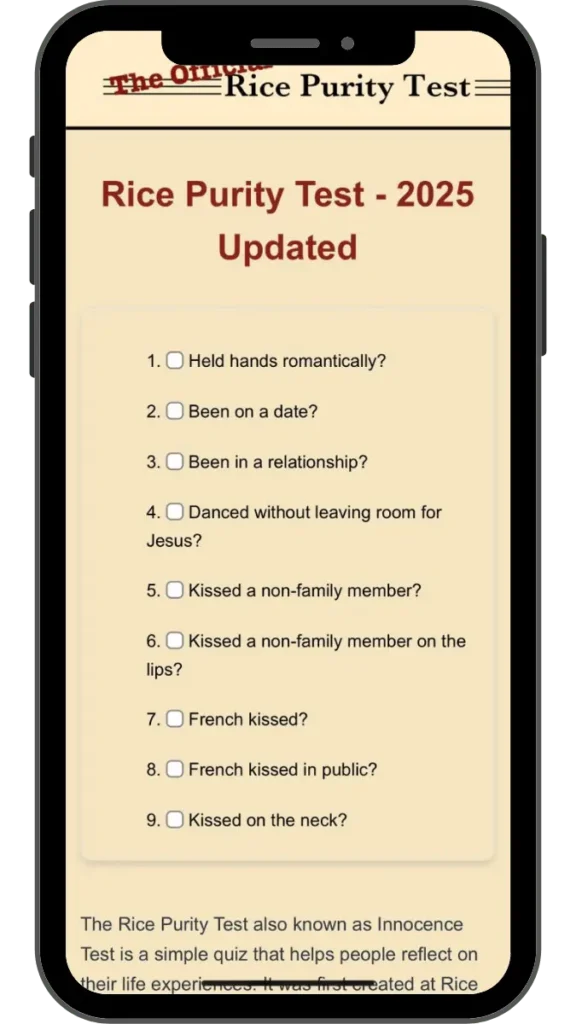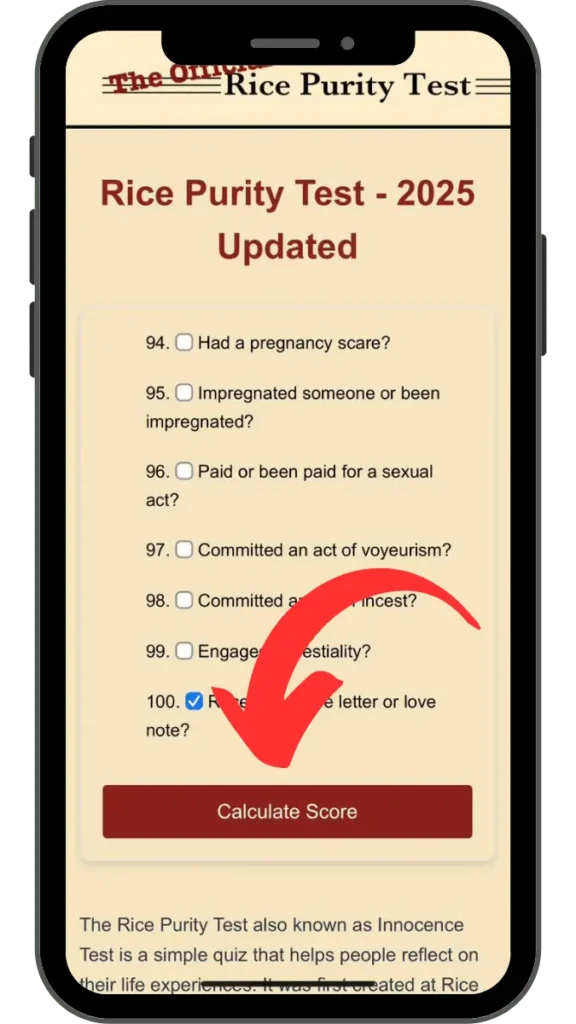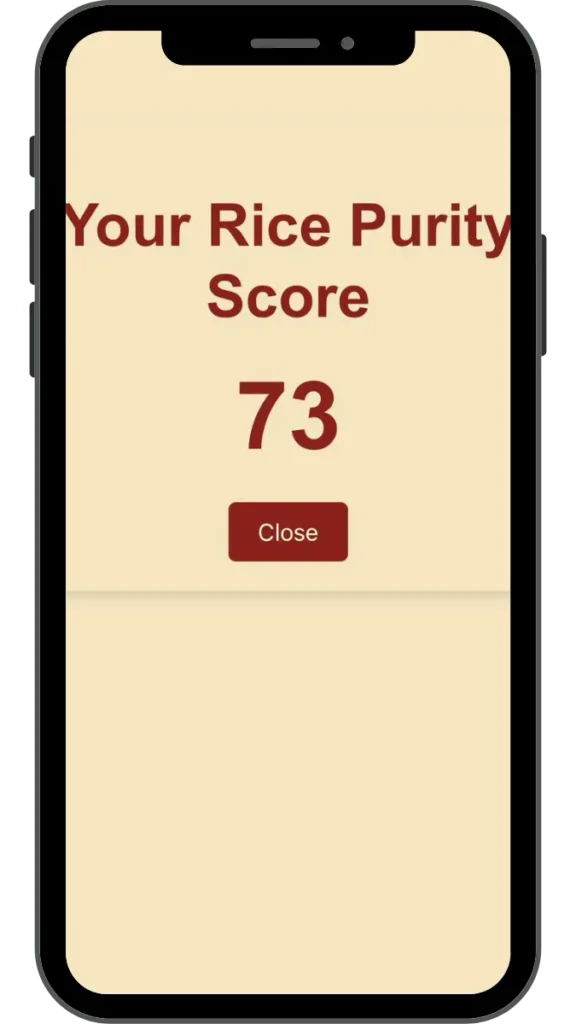Rice Purity Test - 2025 Updated
The Rice Purity Test also known as Innocence Test is a simple quiz that helps people reflect on their life experiences. It was first created at Rice University in Texas as a fun way for students to bond and get to know each other. The test is made up of 100 questions, each asking about different things you might have done in your life. These questions cover friendships, dating, personal adventures, and even some awkward or silly situations.
When you take the test, you just answer “yes” or “no” to each question, depending on whether it applies to you. In the end, you get a score out of 100. A higher score means you’ve had fewer of those experiences and might be considered more “pure,” while a lower score means you’ve had more experiences.
Even though the test is meant to be fun, many people use it to laugh with friends, share stories, or learn new things about each other. It’s not a serious test, and there are no right or wrong answers. It’s a way to explore your past and compare your journey with others.
How to Take the Rice Purity Test Step by Step
Taking the Rice Purity Test is super easy and fun! Here’s how you can do it:
Find the Test Online: Search for “Rice Purity Test” on Google or visit a trusted website like RicePurityyTest.us. Make sure the site is safe and doesn’t ask for personal details.


Start the Test: Once you open the test, you’ll see 100 yes-or-no questions about different life experiences. Each question is simple and easy to answer.
Finish and Get Your Score: After answering all the questions, you’ll see your score. A number between 0 and 100 shows how many experiences you’ve had.


Have Fun With It: Laugh about the questions, remember funny stories, or even share your score with friends. Just make sure you’re comfortable sharing!
Why Does It Matter in 2025?
The Rice Purity Test is still popular today because it’s more than just a quiz—it’s a way for people to connect. In 2025, when so much of our lives happen online, the test feels like a fun, personal way to start conversations. You can take it with friends, share your results on social media, or use it as an icebreaker when meeting new people.
One reason it’s still a big deal is that it taps into something everyone can relate to: curiosity about how your experiences compare to others. Whether you’re at a sleepover, hanging out at college, or chatting in a group text, the test sparks laughs, surprises, and sometimes deeper talks.
It’s also a reminder that everyone’s life is different. Some people might score high because they’ve lived more cautiously, while others might score low because they’ve had a lot of adventures. Either way, it’s all good! The test shows that no matter what your score is, it’s just one part of your story.
Historical Background Of Rice Purity Test
The Rice Purity Test has an interesting history that dates back to the 1920s. It was first created by students at Rice University, a prestigious school in Houston, Texas. The idea was simple: to help new students bond and feel more comfortable with each other. Back then, college life could feel intimidating, and the test served as a fun, non-judgmental way for students to share experiences and laugh about their differences.
Originally, the questions on the test were designed to be lighthearted and covered topics that were common among young adults at the time, like dating, school pranks, and hobbies. Over the years, the test evolved to include more modern topics as society changed. What started as a local campus tradition quickly became a favorite activity for young people across the United States.
How It Became a Global Trend
Fast forward to today, and the Rice Purity Test has grown far beyond Rice University. Thanks to the internet and social media, it’s now popular all over the world. People in countries like the United States, United Kingdom, Australia, New Zealand, France, Germany, Canada, and India frequently share their results online or take the test with friends.
In the United States, the test has become a staple of college culture, often used as an icebreaker during freshman orientation or dorm events. In the United Kingdom and Australia, it’s common to see groups of friends laughing over their scores at parties or in group chats. Countries like France and Germany have also embraced the Rice Purity Test, using it as a fun way to explore differences in social norms and personal experiences.
The test’s global popularity is largely driven by its simplicity and universal appeal. Whether you’re from a big city like New York or a small town in New Zealand, the Rice Purity Test feels relatable. Everyone has a unique story, and the test makes it easy to compare and share those stories in a way that’s both entertaining and thought-provoking.
How the Test Has Changed Over Time
The original version of the Rice Purity Test focused on the experiences of college students in the early 20th century. Over time, new versions of the test have been created to reflect changing lifestyles and social trends. Modern versions include questions about technology, online behavior, and other experiences that weren’t even imaginable a century ago, like:
This ability to adapt is one reason the test remains so popular. It feels current and relevant, even as the world continues to change.
Note: Last Updated on Sunday, 5 January 2025
Structure and Content of this Test
The Rice Purity Test is a straightforward questionnaire with 100 yes-or-no questions, each asking about a different life experience. These experiences range from innocent childhood moments to more adventurous or risqué situations. The questions are grouped into categories that cover a wide variety of topics, making it feel relatable no matter who you are or where you’re from.
Some common themes in the test include:
Each question is designed to be easy to understand and answer. For example, you might see questions like:
The simplicity of the test is part of what makes it so enjoyable. You don’t need any special knowledge or preparation—just answer honestly based on your own life experiences.
Scoring in the Rice Purity Test
| Score Range | What It Means |
|---|---|
| 100 | You haven’t had any of the experiences listed—you’re “pure as snow.” |
| Around 50 | You’ve had a mix of experiences—neither overly sheltered nor particularly adventurous. |
| Closer to 0 | You’ve lived a life full of adventures and stories to tell! |
Note: The score is not about judging anyone. Whether it’s high or low, it’s simply a reflection of your own unique life journey.
Why Are the Questions So Interesting?
The Rice Purity Test is designed to be a mix of fun, surprising, and thought-provoking questions. Some questions are lighthearted, like asking if you’ve ever built a blanket fort or sung karaoke. Others dive into more personal or daring territory, such as trying extreme sports, experiencing heartbreak, or taking risks in your social life.
The variety of topics keeps things engaging. It’s not just about checking off experiences—it’s about sparking memories and conversations. For example, when taking the test with friends, someone might remember a funny story about getting lost on a road trip or share a heartfelt moment about their first big accomplishment.
How It’s Different Around the World
The test’s universal appeal means it resonates differently in various countries. In the United States, it’s popular among college students as a way to bond during orientation or dorm hangouts. In Australia and New Zealand, it’s often taken during house parties or shared in group chats. European countries like France and Germany enjoy it as a casual icebreaker or a nostalgic activity among close friends.
What’s interesting is how cultural norms can influence the way people view the questions. For example:
This global perspective adds another layer of fun and curiosity to the test.
Purpose and Usage
The Rice Purity Test is popular because it’s fun and easy to relate to. People take it for different reasons, like breaking the ice with new friends, laughing over shared memories, or learning more about themselves.
In colleges like NYU or UCLA, students often use it as a way to bond during orientation or parties. It’s also common at sleepovers or road trips, where friends can compare scores and share funny or surprising stories.
Social media platforms like TikTok and Instagram have made the test even more popular. People post their scores and reactions, turning the test into a global trend. It’s now taken in places like Germany, Australia, and Japan, where cultural differences make the answers even more interesting.
Modern versions of the test include questions about things like streaming movies on Netflix, trying new food trends, or going on adventures. This keeps it fresh and relatable to today’s world.
The test is a fun way to reflect on life, bond with others, and share laughs. It shows how everyone’s experiences are different but still worth celebrating.
Taking the Rice Purity Test Responsibly
The Rice Purity Test is meant to be a lighthearted activity—a fun way to reflect on life experiences, laugh with friends, and share stories. It’s important to remember that the test is not a judgment of character, success, or morality. Whether your score is high, low, or somewhere in between, it simply reflects the unique path you’ve taken in life.
For example:
Both are perfectly okay. The key is to enjoy the test for what it is—a playful tool, not a serious evaluation.
Honesty Is Key
When taking the test, it’s important to answer questions honestly. There’s no reward for exaggerating or trying to match someone else’s experiences. In fact, the test is most meaningful when it reflects your true life journey.
Think of it this way:
Protecting Your Privacy
In today’s digital world, privacy is more important than ever. If you’re taking the test online, make sure the website or platform you’re using is trustworthy. Many sites, like Ricepurityytest.us, are reputable and don’t collect personal data, but others may not have the same safeguards.
Here are some tips to protect your privacy:
By taking these precautions, you can enjoy the test without worrying about your personal information being misused.
Skipping Uncomfortable Questions
Some questions on the Rice Purity Test might feel too personal or sensitive. That’s okay! The test is not a requirement, and you can skip any questions that make you uncomfortable.
For example, questions about social situations, romantic experiences, or personal milestones might feel invasive depending on your circumstances. Skipping them doesn’t affect the fun or purpose of the test—it’s all about your comfort level. Therapists at platforms like BetterHelp suggest setting boundaries for yourself while engaging in activities like this. If a question triggers uncomfortable feelings, it’s perfectly fine to leave it blank and move on.
Taking the Test in Groups
While the Rice Purity Test can be a solo activity, it’s often more enjoyable when taken in groups. Whether you’re with friends at a college dorm, colleagues at a team-building retreat, or family during a holiday gathering, sharing answers can spark fun conversations and create lasting memories.
Here’s how to make group testing enjoyable:
Conclusion
The Rice Purity Test is more than just a fun quiz. It’s a way to think about your life and connect with others. It started at Rice University as a game for students to bond, but now it’s taken all over the world, in places like New York, London, Sydney, and Tokyo. The test celebrates everyone’s unique story, whether you’ve lived a calm or adventurous life.
You can take the test alone or with friends. It often leads to laughter, memories, and interesting conversations. It helps people of all ages and backgrounds find something in common, like funny adventures, special memories, or silly mistakes.
New versions, like the Adventure Purity Test or ones about tech, keep the quiz fresh and exciting. Your score doesn’t matter—it’s not about judging anyone. It’s about enjoying your own experiences and celebrating what makes your life special.
So, have fun with the test! It’s a chance to look back, share stories, and connect with others in a world full of amazing moments.
